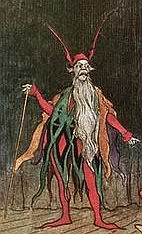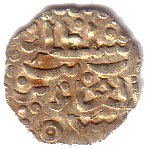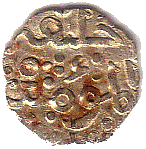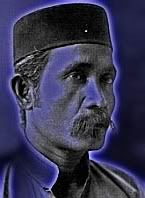Of the C words, I like
ccokoh best. Ccokoh is a way of being, a presence that sticks out, perhaps not like a sore thumb, but prominent enough as to be noticed. Once, in a long distance telephone conversation, I asked after someone, and the answer I got was, "Tu, ada dok ccokoh tu!" It was a description so evocative as to be hilarious.
Dok ccokoh, or
duduk ccokoh says that not only is the person there, but that s/he also stands out in the crowd. The opposite of
duduk ccokoh is probably
duduk ngenda'. The latter is easy for neophytes of Terengganuspeak, as
ngenda' is just the Terengganu rendition of the standard Malay
menghendap, i.e. to hide, or to conceal oneself. In these sentences,
"Dia tu tiak-tiak hari dok ccokoh di keda kopi." [He's there everyday in the coffee shop.]
"Ambo, mung ni dok ngenda' duane lame dak napok?" [Goodness, you've not been seen for a while, where've you been hiding?] both
ccokoh and
ngenda' give added value to the spoken words.
The second line of enquiry may be something I'd like to ask of the
cik ru that you'll find in the list below.
Cik ru is probably the only insect I know that carries an honorific; the other is the
Pak Kor, which is not an insect, but a variety of nodding lizard, hence its full name,
Pak Kor Anggok. I've not seen or heard of the
Mak Kor but I suspect they do exist; otherwise, how's the
Pak Kor to increase its tribe?
But back to
Cik Ru, which brings back memories of sandy soil and the world among the stilts, beneath a Terengganu house. As I remember it,
cik ru was a little six-legged work only slightly smaller than your average household spider, but it was a creature of the sandy earth. The children of Terengganu, or those who knew, thought nothing of spending a few hours of
cik ru hunting in broad daylight, beneath a house. The main characteristic of the
cik ru was that it was completely and utterly useless once caught, as it neither fought nor did it do tricks to amuse, unlike the
kkabor jjetik, the green tapping beetle that went
tap-a-tap-tap on the match-box. The
cik ru remained
in the match-box while the hunter-child spent another hour, maybe two, engrossed in the business of doing a loop in a strand of hair to tether the
cik ru with. Which, actually, was the real test of the job, as hunting the
cik ru was easy as they weren't very good at
ngenda', being a creature that buried itself deep in sandy soil and leaving a dip like an inverted pyramid in the sand directly above its house.
I speak of the
cik ru in the past tense of course, because, I think now, they're up there somewhere with the dodo and the
teh cap buah. So now, the 'c' words then for you to read while you reflect sadly on the
cik ru's past.
calong
candat
catduh
catju
cakne
cakting-cakting
ccamek
ccandat [c. sotong]
ccatung [masang cc.]
ccirik
ccokeng
ccokoh
ccongok
ccolek
ccotek
cebu-ceba
cekor
celober [carek c.]
ceranang
cerlong
cetong
cik ru
cocoh
cok [jilak c.]
cokeh
cokek
colok
cot
cotko
If you know other 'c' Terengganu words, you're more than welcome to add them in the space for comments below. When I have time in between my
cik ru hunting I shall gladly include them, if appropriate, to the list above.
For further notes on
ccandat, please visit this goldmine of Terengganuspeak,
Di Bawah Rang Ikang Kering
Gi mmolek; dok bbaik. Go placidly now, be well.
 is the most gruesome for its Rumplestiltskin effect. The words are not meant to do that in the first place, they merely state a condition, in this case, of someone sitting with legs so apart that it's indecent. So it is normally used of ladies, who sit with legs going in opposite directions. Whilst men sit with knees apart, and the lower legs folded and placed one atop the other, as in bersila, Malay ladies do not; they sit with knees together, pulled to one side, and then the lower legs bent and folded together and pulled back to touch one cheek of the buttocks. This is the bertimpuh, berselimpuh, or betelimpuh position. So kkekeng-ssoyok states an act and the (possible) end result: kkekeng, to sit or stand with legs wide apart, and ssoyok, ripped, torn, as happened to our man in the fairy story when his name was discovered.
is the most gruesome for its Rumplestiltskin effect. The words are not meant to do that in the first place, they merely state a condition, in this case, of someone sitting with legs so apart that it's indecent. So it is normally used of ladies, who sit with legs going in opposite directions. Whilst men sit with knees apart, and the lower legs folded and placed one atop the other, as in bersila, Malay ladies do not; they sit with knees together, pulled to one side, and then the lower legs bent and folded together and pulled back to touch one cheek of the buttocks. This is the bertimpuh, berselimpuh, or betelimpuh position. So kkekeng-ssoyok states an act and the (possible) end result: kkekeng, to sit or stand with legs wide apart, and ssoyok, ripped, torn, as happened to our man in the fairy story when his name was discovered.
 Take kokok for instance, an evocative word to describe the scraping of something hard with something sharp. This sounds and feels Terengganu, but is it? Winstedt lists mengokot as to claw (as a cat), scrape (as a fowl); giving kokot as a bent hook. Then there's pitis for a unit of coinage that is not heard outside Terengganu and Kelantan. I remember seeing it though, in an Indonesian dictionary long before I became interested in words, but that settled it for me even then, that pitis had an outside provenance, but where? Winstedt has an answer to that too, pitis is of Chinese origin, and it was used to describe a very small coin with a hole in the centre, worth less than a half-penny. Anyone out there know what Chinese dialect uses it still? Then there's the keneri [kenderi], the amas, and the dek. And the riyal, of course, which was still very much in use when I was still living in Terengganu, to describe what was then generally known as a dollar, or, nowadays, the ringgit. It is easy to guess where the riyal came from, but whence the origin of the ringgit of standard Malay? The ringgit is a silver dollar, says Winstedt, and beringgit-ringgit is serrated, as of hills.
Take kokok for instance, an evocative word to describe the scraping of something hard with something sharp. This sounds and feels Terengganu, but is it? Winstedt lists mengokot as to claw (as a cat), scrape (as a fowl); giving kokot as a bent hook. Then there's pitis for a unit of coinage that is not heard outside Terengganu and Kelantan. I remember seeing it though, in an Indonesian dictionary long before I became interested in words, but that settled it for me even then, that pitis had an outside provenance, but where? Winstedt has an answer to that too, pitis is of Chinese origin, and it was used to describe a very small coin with a hole in the centre, worth less than a half-penny. Anyone out there know what Chinese dialect uses it still? Then there's the keneri [kenderi], the amas, and the dek. And the riyal, of course, which was still very much in use when I was still living in Terengganu, to describe what was then generally known as a dollar, or, nowadays, the ringgit. It is easy to guess where the riyal came from, but whence the origin of the ringgit of standard Malay? The ringgit is a silver dollar, says Winstedt, and beringgit-ringgit is serrated, as of hills.
 There are, though, words in Terengganuspeak that may have originated there, and those are the onomatopoeic sounds. My mother used to say Gerudung geradang balik pucung. I'm not sure what — or where — balik pucung is, but gerudung geradang is onomatopoeic all right. I remember a few more, kok-kek, kok-kek (to describe a recurring tinkering sound in some daily chore); kiik-kiik the sound of tittering children, and gerudung gerapok as of many people scrambling for cover, in a wooden house probably. We had a man who did our laundry in Kuala Trengganu ( I revert to old spelling as this was way back then), named Tun Long, who hailed from Kuala Berang (Kuala Brang as was), and one day he very succintly described to me the sound of rain. Hujang wek-wek, he said, which filled me with much amazement. When I reported this to my elders, they dismissed it by saying, "Oh, he's from Kuala Berang." It came back to me later in life in another form, from the mouth of Basil Fawlty when dismissing the insane antics of his Spanish Manuel: "Oh, he's from Barcelona, you know." Though Barcelona of course, is a million miles from Kuala Berang.
There are, though, words in Terengganuspeak that may have originated there, and those are the onomatopoeic sounds. My mother used to say Gerudung geradang balik pucung. I'm not sure what — or where — balik pucung is, but gerudung geradang is onomatopoeic all right. I remember a few more, kok-kek, kok-kek (to describe a recurring tinkering sound in some daily chore); kiik-kiik the sound of tittering children, and gerudung gerapok as of many people scrambling for cover, in a wooden house probably. We had a man who did our laundry in Kuala Trengganu ( I revert to old spelling as this was way back then), named Tun Long, who hailed from Kuala Berang (Kuala Brang as was), and one day he very succintly described to me the sound of rain. Hujang wek-wek, he said, which filled me with much amazement. When I reported this to my elders, they dismissed it by saying, "Oh, he's from Kuala Berang." It came back to me later in life in another form, from the mouth of Basil Fawlty when dismissing the insane antics of his Spanish Manuel: "Oh, he's from Barcelona, you know." Though Barcelona of course, is a million miles from Kuala Berang.

